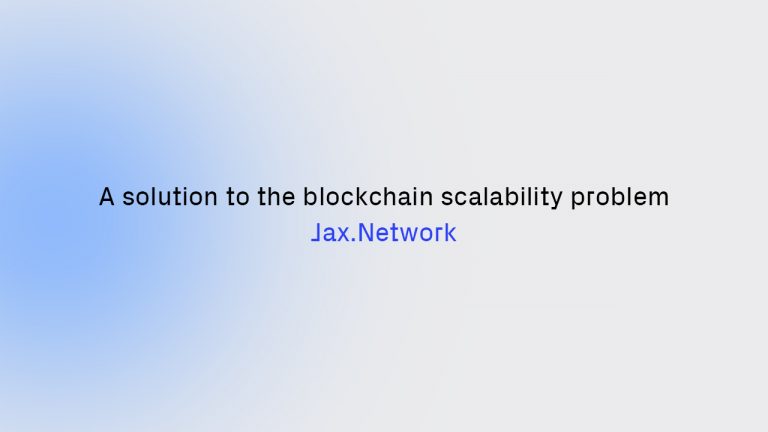PRESS RELEASE. Even though Bitcoin and Ethereum are called ‘cryptocurrencies’ people still treat them like assets instead of currencies. People are not spending cryptocurrencies on a large scale, nor are merchants accepting them on a similar scale. Generally speaking, you still cannot pay for a cup of coffee at your local café with your bitcoin.
Jax.Network, a project based in Kyiv, Ukraine has endeavored to solve this issue. Its goal is to bring cryptocurrency to mainstream day-to-day use by first replacing the stablecoin market, with its decentralized, scalable, Proof of Work based coin ‘Jax Coin’ and then aiming for the greater global payments market after.
A gargantuan goal to say the least, however, it was not born out of a whim. Much thought, time, and research have gone into the project since its inception in 2018. As the project was beginning, members of the newly formed Jax.Network team had one goal: to research and develop a decentralized, scalable, and stable coin that will not sacrifice on security. And from Q3 of 2018 until Q2 of 2020, that is exactly what the team had done and achieved.
An elegant and robust solution to the blockchain scalability trilemma has been created. The solution has been extensively outlined in the whitepaper, the latest version of which was released in October of 2020.
Jax.Network’s Scalability Solution
In short, the Jax.Network protocol plans to use their very own sharding and merged mining solution to ensure the superior scalability of their blockchain. This means that all shards on the Jax.Network blockchain will be protected to the highest degree while being able to continuously scale. The Jax.Network team has claimed that their merged mining solution will be able to prevent 51% attacks much more effectively even on individual shard chains.
Unlike Bitcoin or Ethereum, miners will not be given a fixed reward for solving blocks, rather, they will be compensated based on the computing power they contribute to secure the network (inside the shard chains).
The purpose of this reward function is to achieve balance on the network shards. Whether a miner mines on 1 shard or 100 shards, they will still receive a reward proportionate to the amount of computing power they bring to the network.
Additionally, this is how Jax Coins can claim its status as a relatively stable coin. Since miners are incentivized by profit, they, therefore, follow the law of supply and demand when minting new coins. In other words, miners will mint more coins when the price is high and less when the price is low to drive the price back up. This means that, over time, the price of Jax Coins will be very stable and therefore suitable for day-to-day transactions, similar to the US dollar or Japanese Yen.
The project has even decided to boldly ignore what many other crypto projects have done to achieve scalability, which is to create a Proof of Stake based blockchain. According to Jax.Network’s Chief Economist, Lucas Leger, “Proof of Stake, applied to our network, would increase the concentration of power and be a sacrifice on decentralization.” Leger strongly believes that the Jax.Network’s Proof of Work based blockchain can “achieve the necessary scalability to become a global payment platform without sacrificing the network’s security.”
In fact, everything is linked to the initial coin distribution. In the case of Jax.Network, the peculiar reward function on shards is at odds with proper economic incentives if it were run under a PoS consensus algorithm. Indeed, some economic work has shown that best incentives are preserved when the reward tends to zero and when validation is restricted to the “sufficiently large stakeholders” (Saleh, 2020).
Furthermore, PoW has to be seen as an investment with uncertain returns (Prat & Walter, 2018) due to price fluctuations. Overall, from an economic standpoint, either you would favor a system closer to shareholding with limited responsibilities (in PoS) or a system that relies on favoring entrepreneurship and investments (PoW). Jax.Network have decided to go with the latter, more aligned with economic incentives of the shards reward function.”
From the middle of 2020 until now, the Jax.Network project has been in the development phase of the project. Some of the best minds in blockchain architecture, cryptography, and software development have been hired to work on the development of their protocol. According to the Jax.Network roadmap, they plan to launch their mainnet in Q3 of 2021, but after speaking with members of the development team, their target is much sooner, as soon as late April of 2021.
Jax.Network are also hosting and attending some offline blockchain events in the coming months. They will be co-organizing the BlockchainUA conference in Kyiv, Ukraine on the 26th of March 2021. The BlockchainUA event is claiming to be the biggest offline Blockchain conference in Eastern Europe. Jax.Network have said the purpose of these events is to “start gathering the community of early adopters, supporters, and blockchain enthusiasts who want to impact the market.”
For more information about the Jax.Network project such as its mission, vision, team, roadmap, solution, and more, visit the official website at jax.network.
References
Prat & Walter (2018). An Equilibrium Model of the Market for Bitcoin Mining, Cesifo Working Paper.
Saleh, F. (2020). Blockchain without Waste: Proof-of-Stake. The Review of Financial Studies.
This is a press release. Readers should do their own due diligence before taking any actions related to the promoted company or any of its affiliates or services. Bitcoin.com is not responsible, directly or indirectly, for any damage or loss caused or alleged to be caused by or in connection with the use of or reliance on any content, goods or services mentioned in the press release.










